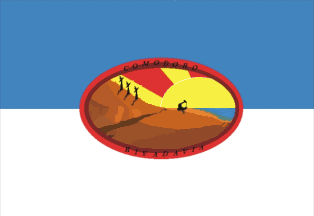
Last modified: 2024-01-06 by rob raeside
Keywords: escalante department | chubut province | argentina |
Links: FOTW homepage |
search |
disclaimer and copyright |
write us |
mirrors
 image
by Blas Delgado, 11 August 2002
image
by Blas Delgado, 11 August 2002
The municipality of Comodoro Rivadavia (173,300 inhabitants in 2010;
566.81 sq. km) is located in central western Patagonia. Comodoro
Rivadavia is the most populous town in Chubut Province and Argentine
Patagonia.
Comodoro Rivadavia was founded on 23 February 1901. The municipality
was named for Commodore Martín Rivadavia (1852-1901), captain of the
corvette "Argentina" that surveyed the area in 1890, on behalf of
Colonel Luis Fontana, first Governor of Chubut. Martín Rivadavia was
the nephew of the statesman Bernardino Rivadavia (1780-1845), the
first head of state of Argentina (President of the United Provinces
del Río de la Plata, 1826-1827).
Oil extraction started in Patagonia in 1907, which boosted the
development of Comodoro Rivadavia, known today as the "National
Capital of Oil". The boom of the town attracted several immigrants;
Comodoro Rivadavia is the proud "Capital of Foreign Communities", with
an impressive list of registered foreign cultural associations
(Galician, Spanish, Argentine-Arab, Bolivian, Italian, Polish, Greek,
Yugoslav, Chilean, Portuguese, Basque, Asturian, Welsh, Paraguayan,
Bulgarian, South African, German, Czech and Slovak, Croat, Andalusian,
former USSR, Brazilian, and Israelite).
The Military Government of Comodoro Rivadavia was established by
Decree No. 13,941 of 31 May 1944, with jurisdiction on Chubut and
northern Santa Cruz. The military presence in the town dates back to
1935, when the 8th Infantry Regiment, founded on 13 July 1813 by
Manuel Belgrano, was relocated to Comodoro Rivadavia.
The flag of Comodoro Rivadavia is prescribed by Municipal Ordinance
No. 7,308 of 21 February 2001. The design proposed by Luis Eduardo
Hammerschmidt was unanimously selected on 26 January 2001 by the jury
made of Ms. Lila H. De Gastaldi, Mariela Córdoba and Liz Cristina López.
The flag is horizontally divided celeste blue-white with an oval
emblem (different from the municipal coat of arms), portraying the
local landscape, in the middle.
Celeste blue and white are the colors of both the country and the town.
The sun in the emblem's background represents the light of hope for
the local people.
The Chenque Hill [a 212 m high hill that divides the town in two
parts] is part of the landscape from which the town emerged.
The windpumps highlight the significance of the windpump park for the
town, recalling that wind is common in the area [the town, nicknamed
"Capital of the Winds", is the cradle of wind energy industry in
Argentina].
The oil wells represent the natural resource that attracted the first
inhabitants of the place.
The sea is another natural resource that contributed to the progress
of the town.
Ivan Sache, 03 March 2002 & 11 August 2013